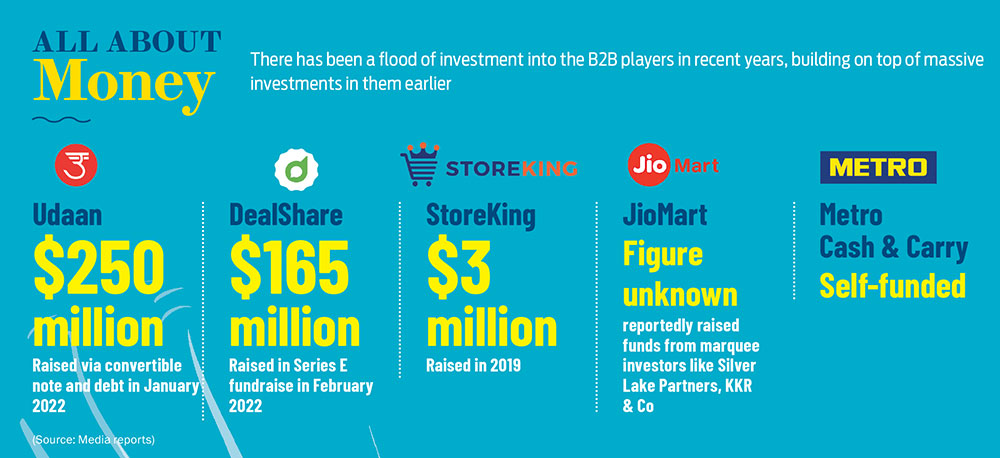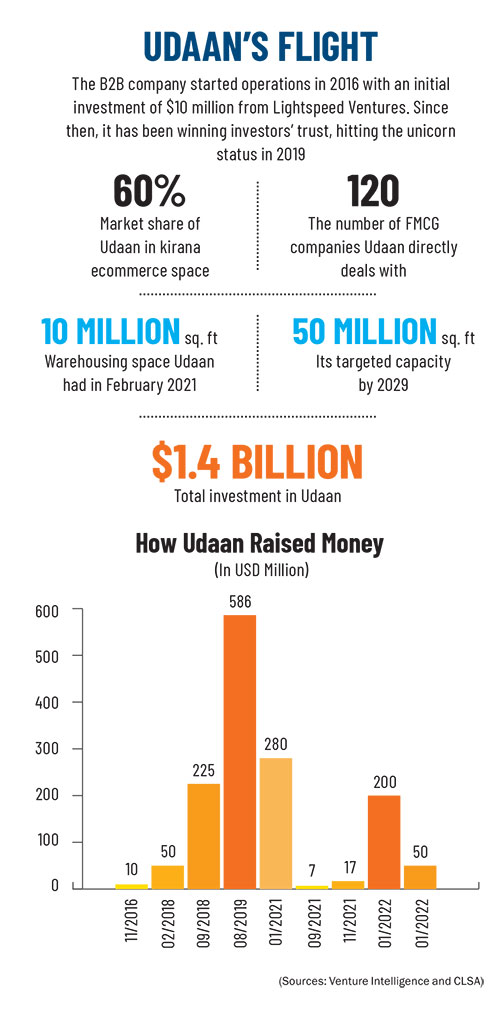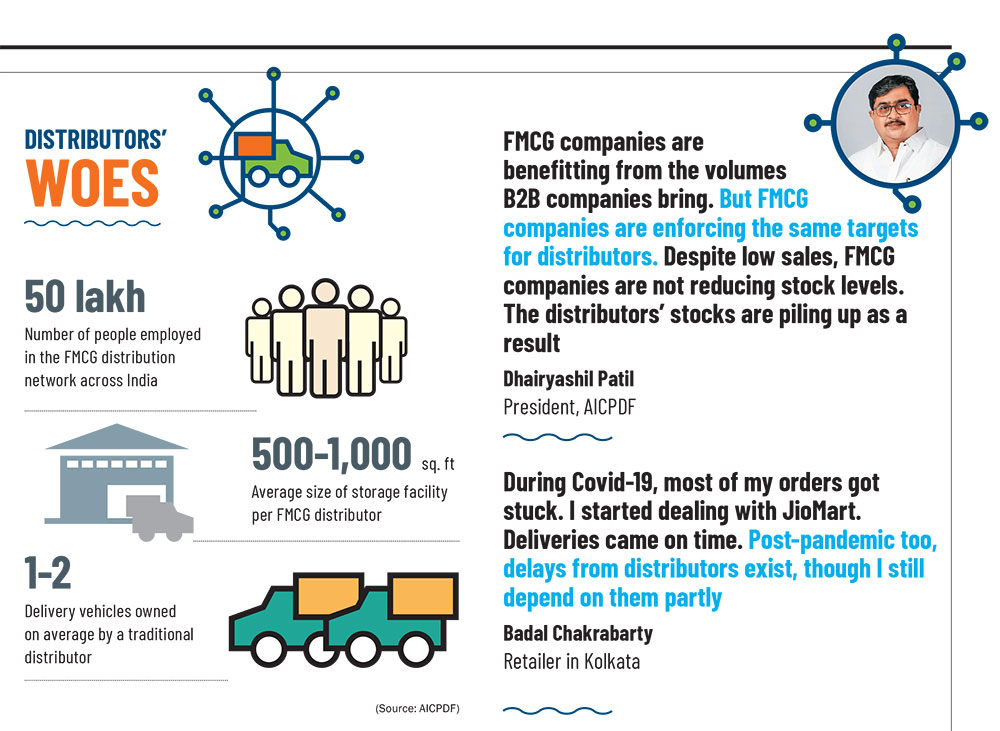After taking a degree in technology in the US, Sumit Aggarwal had no intentions of retuning to India to join his family business. But as is the case with most Indian families, his persuasive parents ensured Sumit was back in India in no time to join the family business. A decade since his return, Sumit has managed to grow his family’s 40-year old business of FMCG distribution, against odds.
What began a decade back, when Sumit returned to India, has now taken shape to redraw India’s FMCG retail industry. It is facing the hour of reckoning, with all its stakeholders—FMCG companies, distributors, retailers and the new crop of B2B players—coming out of old relationships and redefining their partnerships with others.
“There is a sense of despondency. Neither parents nor children in our line of business want to take up the mantle. The narrative has been set. It is our kind of age-old distribution business pitted against modern trade with its attractions of technology, where the later has been made to be the winner,” says Sumit.
The fast-moving consumer goods (FMCG) sector is probably the only segment of the economy that encompasses the rich and the poor, the urban and the rural or any other division this diverse country has. Its vast reach and historical legacy make it the site of competing interests.

The most vulnerable stakeholder today is the traditional distributor of FMCG products. A typical traditional distributor is typecast as a semi-educated middle-aged man—there are very few women in this profession—who lives in a joint family, comes from the trading castes of India and has newly acquired internet literacy of up to the level of smartphones. He is pitted against the suave start-up founders and corporate leaders who talk about raising funds in billions of dollars, have the ears of the current political dispensation and the media and command the technology of digital disruption.
The latter category includes the new business-to-business (B2B) players, like JioMart, Udaan, Metro Cash & Carry, DealShare, Jumbotail and Walmart Best Price among others, which are armed with equity capital, significantly from foreign investors, data analytics tools, access to organised finance, formal delivery chains and information technology. The traditional distributor either lacks the access to most of these tools or has his own rundown versions.
Churn among FMCG Companies
FMCG giants have spent decades to create intricate distribution networks in India by overcoming the challenges of geographical reach and non-static consumer behaviour. New-age B2B companies were trying to break the hold of traditional stakeholders on FMCG distribution networks for quite some time, but they succeeded only post-Covid-19, when the lockdowns gave them the necessary push and put further pressure on traditional supply chains.
JioMart, which was launched in the middle of the pandemic in May 2020, reported a 25% quarter-on-quarter increase in orders by July 2021, of which 70-75% were repeat orders. “JioMart has really come in many ways to the rescue. In a quarter when the store network was stifled, digital commerce and new commerce in many ways contributed about 20% of the business,” Dinesh Thapar, former group chief financial officer, Reliance Retail, had said last year after the release of Reliance Retail’s results.
The boom of these new B2B companies has muddled the sector with a list of accusations made against them, including, but not limited to, disruption of the market through predatory pricing. Distributors allege that the new B2B players sell products on their platforms at rates lower than the ones at which traditional distributors acquire them.
Dhairyashil Patil, president of the All India Consumer Products Distributors Federation (AICPDF), the leading association of distributors in the FMCG space that has been leading their cause against the charge of B2B players, says that B2B players, especially Reliance’s JioMart, tried to change the game during the pandemic. He says that before the pandemic, the influence of B2B players was restricted to certain pockets, and distributors did not see them as a grave threat. “By 2016-17, B2B companies, like Udaan and StoreKing, had started operations. Retailers were called in by these companies for purchase at a discounted rate, but the discounts offered were not lower than the landing cost of distributors. Also, sales from there were not more than 10% of the entire FMCG sales of the country. But, JioMart came in with a lot of capital,” he says.
Distributors had started getting alarmed much before the entry of JioMart in the sector, as they sensed the market changing dynamics. Their associations started petitioning FMCG companies to address issues like predatory pricing and overlap of territories. “In November 2019, we wrote to these companies. Udaan, StoreKing and the likes had specifically said that they would service the markets which are not covered by the [conventional] distribution network. But, it was observed that they were selling to the same set of outlets that distributors catered to at some manageable lower cost,” says Patil, adding that distributors brought it to the notice of FMCG companies, which assured them they would resolve it at the end of B2B players.
Some FMCG companies responded to the distributors’ concerns, while others found a better proposition endorsing the business model of B2B players. At least two companies took a firm stand in favour of their distributors. Amul and Parle stopped direct supplies to Udaan in September 2021 and accused it of monopolising the distribution channel. Amul managing director R.S. Sodhi said that the company’s decision was directed at protecting the interests of its distributors.
Subsequently, Udaan filed a complaint with the Competition Commission of India against Parle for its refusal to supply its popular biscuit brand Parle-G to the B2B giant. Udaan alleged that Parle’s decision amounted to monopolistic behaviour.
While Patil bats for a return to the old ways of the distribution system without B2B players dominating the landscape, Sumit is more realistic: “The demand of banning B2B players is extreme. The intelligent thing for us would be to ensure harmonious co-existence, where we benefit from each other’s strengths.” But do the B2B players agree?

ACT I
Udaan: The Birth of Modern B2B Mantra
By all indications, Udaan and JioMart are two of the largest players in the B2B segment of the FMCG sector. However, the exact share of their market size or investment may not be known. In some measures, modern B2B platforms have existed for a long time, but the inflexion point for them came with the arrival of Bengaluru-based Udaan on the horizon, which was founded in 2016 and became a unicorn in two years.
The rise of Udaan coalesced two trends in the Indian retail segment. First, it was a logical extension of the large investments funders had made in the ecommerce space. Flipkart and Amazon had redefined shopping in India and unilaterally created the digital retail consumer across the country. This behavioural change was aided by largescale internet penetration, which was a larger policy intervention, and massive investments in supply chains and technology that, on the one hand, disturbed the existing retail equilibrium and, on the other, created retailers who sold only on ecommerce platforms.
This background ran its course for almost 10 years—from the founding of Flipkart in 2007 till Udaan started becoming visible—albeit never making profits while ecommerce revenue kept rising, and ensured that India was ready for the next logical extension of digital trade journey.
“Had we not seen such a massive internet penetration, especially of mobile internet, India would have followed the Western evolution of the market, where increasingly distributors would have expanded their reach and the wholesale businesses gone to them. What we now see is a huge opportunity for tech-oriented companies on building the right systems and connecting the last point of contact for consumers, which are the kirana stores,” says Vineeth Rao, founder and CEO of app-based buying platform DealShare.
The second trend, which is particularly true of Udaan, was that India’s tech entrepreneurs who were part of the ecommerce evolution had been replaced by a new crop of managers in those companies as investors forced leadership change and took executive control. The restive IIT graduate, who had got seasoned in the ecommerce space in the last decade and still had youthful energy left in them, was sitting idle with a pile of cash, contacts in the funding industry and vision of copying another global idea in the start-up space. Thus, was born another digital leader in India in Udaan, which came to be identified with the supply chain disruption the way Flipkart became the symbol of B2C disruption.
Logic of Consolidation
As Patil noted above, modern B2B players were careful not to tread on distributors’ toes initially. They took quiet, but firm, steps in joining the dots for building a complete supply chain for an eventual, full-blown assault on the target later.
Sample this: In February, Udaan announced in a statement that it had built a warehousing capacity of 10 million square feet across India and planned to raise it to 50 million in “the next seven to eight years”. Thus, from signing up with FMCG companies for a direct bargain for deep discounts, investing in tech and data analytics, covering geographies one by one to creating a massive chain of warehouses, the modern B2B players showed industry watchers how mammoth supply chains could be built within years.
Udaan claims to be a B2B platform for “Bharat”. Its website is peppered with words like transform, small and medium enterprises, low-cost, inclusive, transparency, accessibility, empower, etc. If it were not a unicorn, an observer may confuse it with a well-funded non-profit discharging the white man’s burden in a former colony. In 2019, the company made seasoned actor Pankaj Tripathi its brand ambassador, who exhorts kirana store owners to download the Udaan app in its commercials. Tripathi complements Udaan’s branding by making it look like a company that bats for the interests of small countryside retailers who get a raw deal in the existing distribution network and, thus, need emancipation.
ACT II
The Distributor in ICU
But distributors are not impressed. They argue that modern B2B players may be using this positive pitch to counter the criticism that they expect from disrupting a low-cost, employment-generating, profit-making distribution network to an equity-driven disequilibrium. Sumit says that irrespective of the distribution channel, be it traditional or modern B2B platform, big retailers always drive a better bargain. The small retailers of Bharat are still overlooked.
To Sumit’s grievances Patil adds that B2B players are entering into territories that are profit areas of traditional distributers, including big retailers in urban centres and fast-moving top brands of FMCG companies. Both generate high volumes for people like Patil and Sumit.
The logic of high volumes getting a better price to retailers also applies to modern B2B players when they negotiate with FMCG companies and gives them the edge that traditional distributors can never have. Patil says, “The number of FMCG distributors in the country is about five million, but the whole space is segmented. An average distributor has only about 500 to 1,000 square feet of warehousing space and has one or two delivery vehicles. These factors hinder the distributor’s ability to bargain.”
What worries the likes of Patil is that modern B2B players use the might of their aggregate demand and buy only top products from FMCG companies at a lower rate and then discount these products to the same set of retail outlets that distributors sell to.
Many distributors’ bodies launched lobbying campaigns and protests against FMCG companies, most notably in Maharashtra earlier this year, where they accused companies of favouring B2B players.

Dying a Fast Death
It is worth asking why the age-old distribution network seems to have submitted itself to largely two big players in the B2B space. Most distributors seem to be agitated about Udaan and JioMart, while they are willing to coexist with others.
The outbreak of Covid-19 and the events surrounding it dealt a body blow to traditional distributors. First, the pandemic disrupted their established supply chains through lockdowns. Their workers were compelled to leave cities and towns and fend for themselves. When lockdowns eased, not all workers returned or returned swiftly enough. Moreover, distributors’ supply channels with FMCG companies broke at the outset. The more-organised B2B players were not only able to take better care of their employees, they could also ensure continuation of supplies due to their large warehousing capacity, not to mention the lobbying power they had with local administration to obtain curfew passes and letting their vehicles pass.
Distributors should have seen this change coming. Is it distributors’ lack of access or inclination to engage with high-quality research on supply chains around the world, especially with respect to Walmart and Alibaba, that is responsible for this apathy? Is it the education status of an average distributor? Is it too much faith in the government’s ability or desire to protect the distributor who, collectively, forms a large voting block? Or, is it a meek submission to “an idea whose time has come”?
“The old distribution model is not suffering because it is inefficient. It is suffering because traditional distributors do not have any guidance or tools to know what they are doing wrong,” argues Sumit.
Sanaa P.R. (name changed on request), a former employee at Udaan’s category division, says, “B2B players too have problems catering to small retailers. While the pitch deck story is that the ultimate objective of the Udaans and JioMarts of the world is to democratise distribution and provide the right price to small retailers, the fact of the matter is that to serve a small retailer is costly for them too, just as it is for the general distributor.” This is where the redemption for the traditional distributor may lie, if at all, in a price-conscious society, just as the fear of annihilation of informal retail have proved fanciful so far. B2B players, in the long run, may be constrained to defy their pitch decks and settle for a segment of the FMCG distribution pie.
Meanwhile, the government is still watching the brute world of competition from a distance, still promising to create a policy for the ecommerce space and still waiting for scholarly inputs to define the perfect competition. For now, the distributor hopes that the wait does not increase Sumit’s despondency and turn the Indian FMCG sector into a Broadway tragedy.











